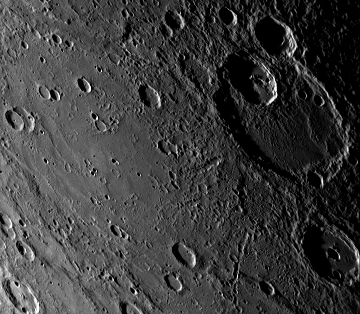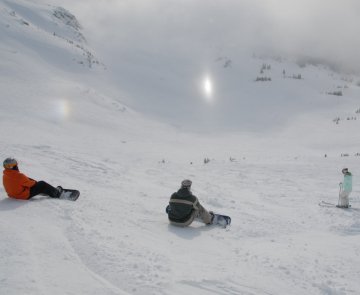 Where's Saturn? Is that a UFO--or the ISS? What's the name of that star? Get the answers from mySKY--a fun new astronomy helper from Meade. Where's Saturn? Is that a UFO--or the ISS? What's the name of that star? Get the answers from mySKY--a fun new astronomy helper from Meade. NACREOUS CLOUD ALERT: A wave of nacreous clouds is sweeping across the Arctic Circle this evening producing vivid iridescent displays over much of Scandinavia. Sky watchers in Canada and Alaska should be alert for similar apparitions over their part of the world; the best time to look is during the hours around sunset. photos: from Morten Ross of Oslo, Norway; from Håkon Dahle of Fjellhamar, Norway; from P-M Hedén of Vallentuna, Sweden; from Greger Gimseus of Bålsta, Sweden CRATER MATISSE: French painter Henri Matisse is famous for his expressive use of color. Ironic, then, that Crater Matisse should be so boldly gray: 
That's Mercury for you. The rocky home of Crater Matisse is a world of subtle color and desolate beauty that Matisse would probably appreciate if not mimic. NASA's Messenger spacecraft took the picture during an historic flyby of the planet on Jan. 14, 2008. On Mercury, craters are named for people (deceased) who have made important contributions to the arts--e.g., Matisse, Vivaldi, Sholem Aleichem and many others. Crater Matisse was christened in the 1970s after its discovery by Mariner 10, the first spacecraft to visit Mercury. Last week, Messenger photographed nearly six million square miles of previously unseen terrain containing thousands of new and unnamed craters. The International Astronomical Union (IAU), which oversees the process of naming landmarks on other worlds, has some catching up to do. FORGET THE SKIING... Look for the halos! Ski slopes are excellent places to spot sundogs and other luminous ice halos, which appear when sunlight shines through ice crystals in the air. Spaceweather reader Mike Conlan sends this report: "Last week, I was skiing on Blackcomb Mountain in Whistler, British Columbia, when I noticed a peculiar bright light below the sun with 'sundogs' on either side of it: photo. A snow storm was diminishing with about 60 km/h winds, so there was a large amount of small-particle snow blowing around." (continued below) 
"My friends and I sat and watched the sundogs directly in front of us from the top of the world for quite a while! Luckily I was skiing with my Nikon D200 to capture this unique sight." The lights that mesmerized Conlan's party are called subparhelia. "Ski slopes let us look downward to see halos normally located below the horizon," says atmospheric optics expert Les Cowley. "Here we have sub-horizon halos made by six-sided plate crystals." People often think that 'sub-sundogs' are somehow reflections of true sundogs above. Not so, says Cowley. "They are not reflections of the sundogs but are formed by rays following sundog paths that, inside the crystal, happen to collide and reflect from a vertical crystal facet. The subsun directly below the sun can often also be seen on airplane journeys." | 
